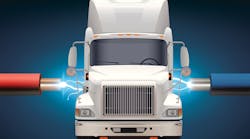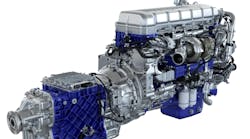What will power new electric transportation technology?
As more and more nations declare their intention to prohibit the sale of fossil fuel-powered vehicles, attention naturally shifts to efforts to develop electric vehicles that can meet the performance requirements of demanding duty cycles.
Since the introduction of electric vehicle (EV) technology, by far the largest focus has been on the ability of these vehicles to have the power and range of their conventionally fueled cousins. This centers attention on the battery and its ability to both store energy (range) and discharge power (acceleration).
Battery electric vehicles have been around nearly as long as the automobile; however, the primary barrier to their commercial adoption has been that EVs lacked sufficient range to compete with their cousins with internal combustion engines. The lack of range was a function of the batteries and the conundrum vehicle manufacturers faced: To get range required more batteries, but the more batteries, the heavier the vehicle, which reduced range. Acceleration has been another challenge, and manufacturers have long struggled with finding battery technology that balanced energy storage with the capacity to discharge power rapidly.
The first efforts to produce commercially viable EVs that addressed these issues used conventional lead-acid batteries. Virtually all the battery and plug-in electric models on the market today employ lithium-ion technology. Lithium-ion batteries are the best at matching sufficient energy storage with the capability of providing high-performance acceleration.
This technology has pushed EVs closer to the mainstream, but there remain significant limitations to lithium-ion batteries, including safety concerns, a challenging weight-to-performance conundrum, and the emerging issues related to use of increasingly scarce and ethically challenged cobalt as a critical metal in the cathode.
Below we look at some leading contenders to power the next generation of electric transportation technology.
Solid-state batteries: A solid-state battery is a technology that uses both solid electrodes and solid electrolytes, instead of the liquid or polymer electrolytes found in lithium-ion or lithium polymer batteries. Solid-state batteries are projected to be smaller, less costly and have higher energy density than the technologies that currently dominate the market, such as lithium-ion batteries. Several projects are currently underway to develop and commercialize the promising energy storage device.
Major OEMs from Mitsubishi, Nissan and Toyota are working on developing solid-state battery technology that is expected to come to market between 2025 and 2030.
Proton batteries: In early March, a research team led by John Andrews from the Royal Melbourne Institute of Technology (RMIT) published an article in which they claimed to have developed a rechargeable proton battery. The working prototype invented by RMIT scientists uses a carbon electrode to store protons as hydrogen ions. The protons are created from electrolysis powered by an electric circuit. The electricity is released from the carbon electrode by reversing the process.
Graphene-based energy storage: One of the most exciting developments in the energy storage space is the use of graphene, an ultra-thin form of carbon that has the conductivity characteristics of a super or ultra-capacitor. Not only is graphene thin—it is superconductive at only one atom thick—it is also a remarkably strong, flexible and lightweight material.
In 2012, the University of California, Los Angeles (UCLA), a team published a paper demonstrating research that had, for the first time, created a graphene electrode that maintained high energy density (range) coupled with high power density (speed). What is more, the graphene-based technology developed by UCLA scientists could be charged a hundred to a thousand times faster than conventional batteries.
You can learn more about the evolving vehicle battery technology landscape at ACT Expo, April 30 – May 3 in Southern California.




